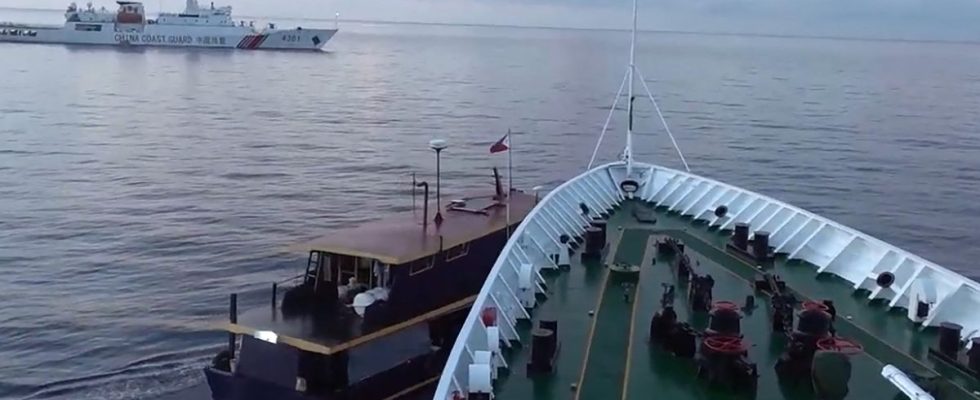Tensions rise between China and the Philippines after two boat collisions in the South China Sea. Manila thus accused Chinese ships on Monday of having “intentionally” rammed Philippine boats twice on Sunday near the Second Thomas Shoal atoll, in the Spratlys, where the Philippine navy is stationed and where Beijing deploys ships to assert its territorial claims. The two countries share responsibility for these clashes. Return to the clashes at the origin of the tensions.
Skirmishes at sea
Two incidents in the same day is a lot. Too much for the Philippine authorities. According to Manila, a supply boat collided with a Chinese coast guard vessel due to the latter’s “dangerous blocking maneuvers” about 25 km from the coral island. Beijing, for its part, cited a “slight collision” after the Philippine boat ignored “multiple warnings and deliberately crossed the police in an unprofessional and dangerous manner,” according to public television CCTV, citing the Ministry of Affairs. foreign.
In another incident, a Philippine Coast Guard vessel escorting the resupply mission was “struck” by what Manila called a “Chinese maritime militia vessel.” Beijing, however, accused the Philippine boat of having “deliberately” caused a collision by backing up in a “premeditated” manner towards a Chinese fishing vessel.
A video released by the Philippine military shows the bow of the Chinese coast guard ship and the stern of the Manila supply ship briefly touching. Then the Philippine ship continued on its way without it being possible to determine whether there had been any damage. For Beijing, “responsibility for Sunday’s incidents lies entirely with the Philippines.” Manila and Beijing thus blame each other for two collisions.
The wrath of Manila
“Chinese Coast Guard and maritime militia vessels, in flagrant violation of international law, intentionally harassed and struck the Unaiza May 2 and the Philippine Coast Guard vessel BRP Cabra” during “legitimate rotation and demolition operations.” resupply in the exclusive economic zone of the Philippines,” Philippine Defense Minister Gilbert Teodoro told reporters.
“We are here to denounce in the strongest terms this blatant violation and illegal act in the 200 nautical mile exclusive economic zone and the obfuscation of the truth by China, which distorts history to achieve its own ends », added the minister. The remarks come hours after Philippine President Ferdinand Marcos Jr. met with security officials and ordered the coast guard to investigate the incident, which was “taken seriously at the highest levels of government,” according to its communicators.
Diplomatic pressures activated
Following the incidents, Manila summoned the Chinese ambassador while Beijing issued a “solemn” protest to the Philippines. Chinese Ambassador Huang Xilian, unavailable, was represented by his deputy head of mission. “Ayungin Shoal is part of our exclusive economic zone and continental shelf, and we have sovereign rights and jurisdiction over it,” added Teresita Daza, spokesperson for the Philippine ministry.
Beijing, for its part, sent a “solemn” protest through diplomatic channels to the Philippines, expressing its “strong dissatisfaction” and its “firm opposition” after the “intrusion” of Philippine ships around the disputed atoll, according to the Chinese Embassy in Manila.
Disputed maritime territory
Beijing claims almost the entire South China Sea despite rival claims from the Philippines, Vietnam and Malaysia, ignoring a 2016 international judgment which found it wrong.
The collisions came as the Philippines was conducting a routine resupply mission for its troops at the isolated outpost about 200 km from the Philippine island of Palawan and more than 1,000 km from the nearest major Chinese island. , Hainan.
In 1999, the Philippines deliberately ran a military boat, the BRP Sierra Madre, aground on the atoll with the aim of installing troops there and asserting its claims to sovereignty against China. The ship has since been a source of tension between Beijing and Manila. The Philippine Marines on board depend on resupply missions to survive.

